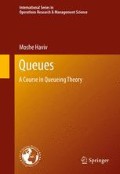Abstract
So far we have assumed that all customers are treated equally. In particular, the next to enter service could not be decided due to certain parameters that are customer-dependent. This was the case regardless of which of the FCFS, LCFS, or random-order policies was assumed. In this chapter we deviate from this assumption and allow some discrimination among customers. Thus, some customers may be treated better than others.
Access this chapter
Tax calculation will be finalised at checkout
Purchases are for personal use only
Notes
- 1.
This fact does extend to distributions. Specifically, the distributions of the number of customers in the system, under the FCFS and the LCFS discipline coincide. This is not the case for the distributions of waiting times.
- 2.
This proof appears in [8], p. 250.
- 3.
A heuristic proof sometimes goes as follows. The queueing time of a class i customer is decomposed into three parts. The first part is due to the residual service time of the one (possibly) currently in service. This value has a mean of W 0. The second component is due to service times of those customers he/she finds in the queue of classes 1 through i. The contribution of this part is with a mean of \(\Sigma _{j=1}^{i}L_{j}^{q}\overline{x}_{j}\) which, by Little’s law, equals Σ j = 1 i W j q ρ j . The final component is due to service times of customers of classes 1 through i − 1 that arrive during the queueing time of the tagged class i customer and hence are serviced before he/she is. It is claimed that the mean of this component is \(W_{i}^{q}\Sigma _{j=1}^{i-1}\rho _{j}\). The justification is based on the heuristic argument that since the class i customer spends time in the queue whose mean equals W i q and since the arrival rate of class j is λ j with each of its arrivals contributing a mean waiting time of \(\overline{x}_{j}\), the total mean delay due to class j is \(W_{i}^{q}\lambda _{j}\overline{x}_{i} = W_{i}^{q}\rho _{j}\), 1 ≤ j ≤ i − 1. This claim is correct but needs to be argued due to the fact that the time in the queue of the class i customer and the service times of those who arrive while he/she waits and receive service before he/she does are not independent. Hence, taking the products of expected values, namely, \(\lambda _{j}\overline{x}_{j}\) times W i q, to reflect the mean contribution of class j, 1 ≤ j ≤ i − 1, calls for justification. A full proof was given by Cobham [13] who was the first to find the formulas above. An alternative proof appears in [15]. The latter reference comes with a stronger result: the generating function of the joint distribution of the various queue lengths.
- 4.
This exercise appears in [8], p. 250.
- 5.
A simpler proof is to say that L i q is the same here as in the corresponding FCFS case. Hence, by Little’s law, the same holds for W i q.
- 6.
This model and the results below appear in [26].
- 7.
The original result and proof can be found in [36], pp.172–174.
References
Bertsekas, D. P., & Gallager, R. (1992). Data networks (2nd ed.). Englewood Cliffs: Prentice Hall.
Cobham, A. (1954). Priority assignment in waiting line problems. Operations Research, 2, 70–76.
Cox, D. R., & Smith, W. L. (1961). Queues. London: Chapman and Hall.
Haviv, M., & van der Wal, J. (2007). Waiting times in queues with relative priorities. Operations Research Letters, 35, 591–594.
Kleinrock, L. (1976). Queueing systems. Vol 2: computer applications. New York: Willey.
Schrage, L. E. (1968). A proof of the optimality of the shortest processing remaining time discipline. Operations Research, 16, 678–690.
Schrage, L. E., & Miller, L. W. (1966). The queue M/G/1 with the shortest processing remaining time discipline. Operations Research, 14, 670–684.
Author information
Authors and Affiliations
Rights and permissions
Copyright information
© 2013 Springer Science+Business Media New York
About this chapter
Cite this chapter
Haviv, M. (2013). Priorities and Scheduling in M/G/1. In: Queues. International Series in Operations Research & Management Science, vol 191. Springer, New York, NY. https://doi.org/10.1007/978-1-4614-6765-6_5
Download citation
DOI: https://doi.org/10.1007/978-1-4614-6765-6_5
Published:
Publisher Name: Springer, New York, NY
Print ISBN: 978-1-4614-6764-9
Online ISBN: 978-1-4614-6765-6
eBook Packages: Business and EconomicsBusiness and Management (R0)

